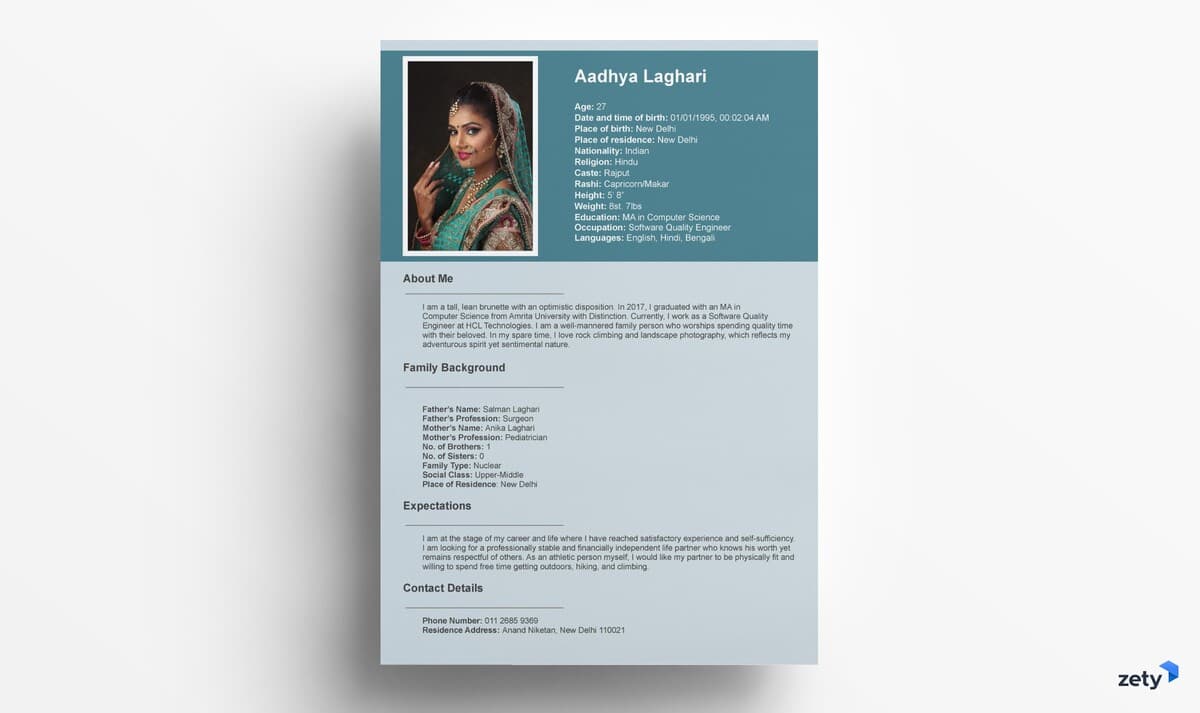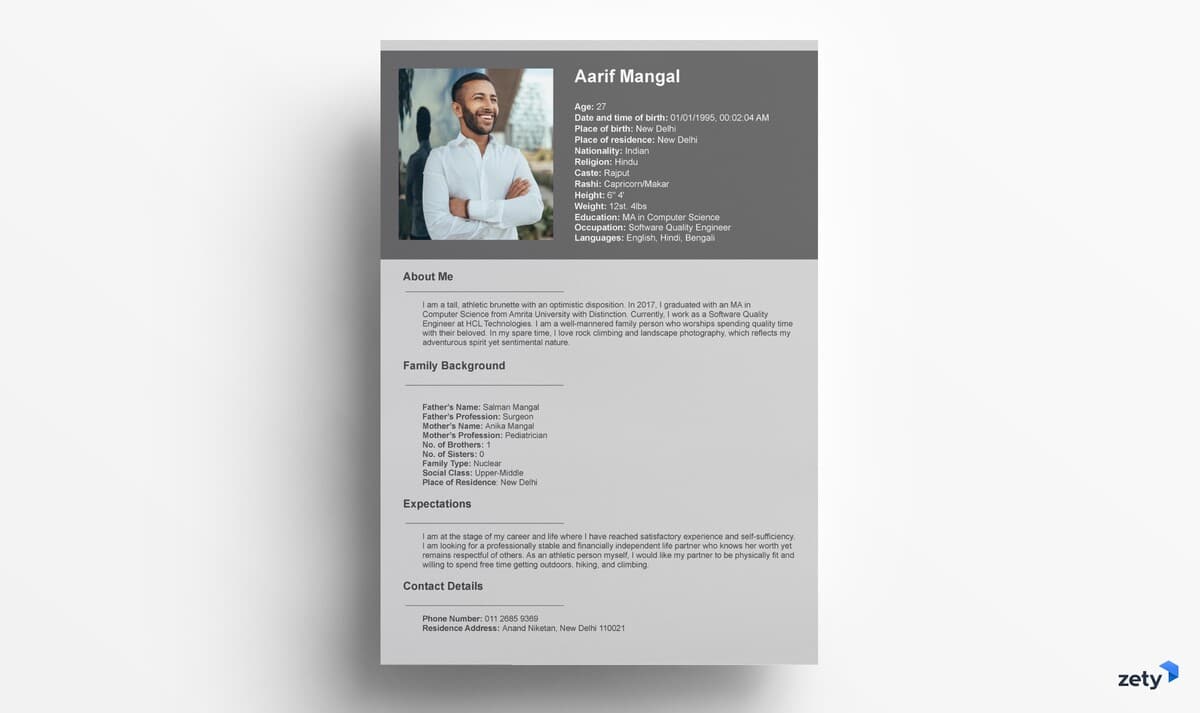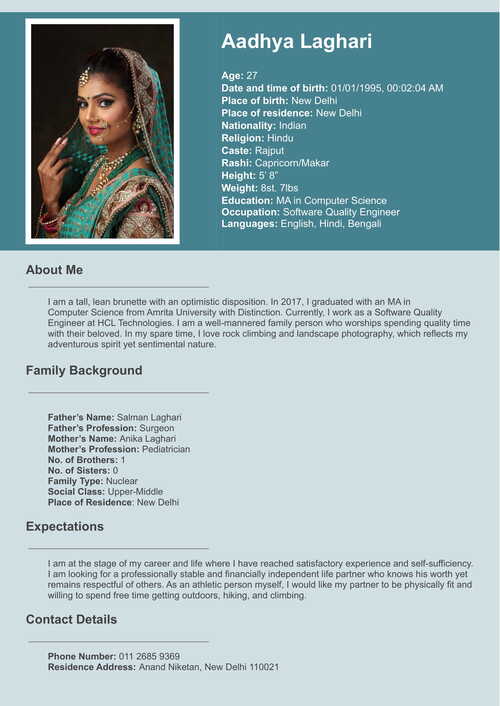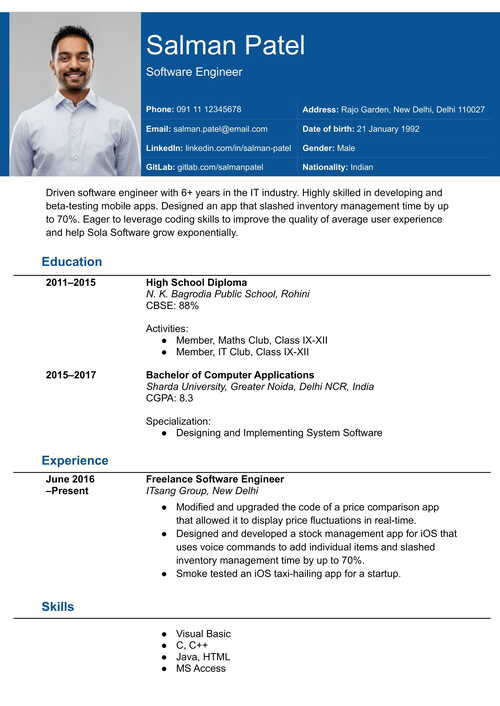
Free Biodata Templates for Marriage and Job Format
Looking for a perfect biodata format? For marriage or job? Here you’ll find everything you’ve been wanting. And get free downloadable templates on top of that.
Looking for your better half? Or perhaps chasing a lifetime job opportunity? Both areas are fiercely competitive, and you can’t bend the rules.
But we’ve got you. We’ll help you craft a proper biodata format for marriage and job. It’ll be hard to resist your potential once you’re done.
This guide will show you:
- Biodata templates for marriage and a job better than 9 out of 10 others.
- A biodata format that creates favourable opportunities in both areas.
- Step-by-step guides on how to make a marriage biodata and a biodata format for a job.
- Frequently asked questions about the biodata format.
Zety can help you create memories worth a lifetime. Have a go with the Zety builder features that allow you to create a biodata template that nobody will be able to resist. Help us help you achieve the next step in your career or find someone to enjoy your success with.
Use our templates to create a biodata format that attracts your future job or a life partner.
Not so sure the biodata is what you need for a job? Why don’t you have a go and see How to Make a Resume: Guide With a Sample
But if you are, here’s a bonus for you! Free biodata templates for marriage and job to download here:
- Free Biodata Template for Marriage for a Girl
- Free Biodata Template for Marriage for a Boy
- Free Biodata Format for a Job
In this article, you’ll see:
- How to Make a Marriage Biodata
- Biodata Templates for Marriage
- How to Write a Biodata Format for a Job
- Biodata Template for a Job
- Frequently Asked Questions about Biodata
How to Make a Marriage Biodata
The thought of settling down can fill you with dread intensely enough to set writing your marriage biodata aside. But taking the first step is always the hardest part. We’ll help you, so you don’t walk alone.
Let’s dive into the blueprint for a perfect marriage biodata format:
1. Include Your Personal Information
This section is a prelude. Fill it out, saying as much as possible using as few words as possible. Here’s what you should include:
- Full name
- Age
- Date and time of birth
- Place of birth
- Place of residence
- Nationality
- Mother tongue
- Religion
- Caste
- Subcaste
- Gotra
- Rashi
- Physical features, i.e., height and weight
- Education qualifications
- Occupation
- Contact details, i.e., email address and phone number (landline and mobile)
2. Attach a Professional Photo
Make the reader not able to take their eyes off of you. Let them stick around for a little longer using a picture of you worth more than a thousand words.
A professional photographer should ideally take the photo you’ll include in your marriage biodata format. They’ll know how to pose you to bring out your qualities. One taken by your smartphone with several filters won’t do you any good. Most likely, you don’t find seeing enhanced photos attractive, too.
Keep in mind wearing appropriate clothing and a smile.
3. Write the About Me Section
You’ve done it a hundred times already. However, you didn’t have to impress much. Now, you truly have to.
So start by describing your physical appearance, followed by your academic and professional status alongside your best achievements, and end with your hobbies and interests. Please also disclose any disabilities and status if divorced or widowed.
This is an example of how you could phrase the about me part of your biodata for marriage:
Biodata for Marriage—About Me Example
I am a tall, lean brunette with an optimistic disposition. In 2017, I graduated with an MA in Computer Science from Amrita University with Distinction. Currently, I work as a Software Quality Engineer at HCL Technologies. I am a well-mannered family person who worships spending quality time with their beloved. In my spare time, I love rock climbing and landscape photography, which reflects my adventurous spirit yet sentimental nature.
4. Mention Your Family Information
Marriage is not only the union of two people but also of families. And yours play a considerable role in your marriage biodata format. Limit yourself to providing only the information about your closest ones, parents and siblings.
Here’s what you should include in your family background section:
- Father’s name
- Father’s profession
- Mother’s name
- Mother’s profession
- Number of brothers
- Number of sisters
- Family type, i.e., joint or nuclear
- Social class, i.e., lower, middle, upper-middle, or upper class
- Place of residence
5. Be Clear About Your Expectations
Finally, a section where you can express what it is that you want. Make sure not to skip anything you deem essential in your partner. In fact, it’s a good idea to make a bullet point list of the qualities you’re seeking. Then put them all together and prepare a short description.
Let’s see if you stand a chance at the example below:
Marriage Biodata Format—Partner Expectations Example
I am at the stage of my career and life where I have reached satisfactory experience and self-sufficiency. I am looking for a professionally stable and financially independent life partner who knows their worth yet remains respectful of others. As an athletic person myself, I would like my partner to be physically fit and willing to spend free time getting outdoors, hiking, and climbing.
You’re looking for someone you’d like to spend the rest of your life with. Give this section all the attention it calls for. And then a bit more.
And now that you’re done, you’re ready to see how this information looks on a perfect biodata template for marriage:
Biodata Templates for Marriage
Marriage Biodata for a Girl

Marriage Biodata for a Boy

How to Write a Biodata Format for a Job
Everyone fears rejection, especially when the only way to introduce yourself is with a single sheet of paper. So to dispel any dilemma on how you should present yourself to your potential employer, let’s dive into how to make a job biodata format they won’t say no to.
1. Design a Biodata Format on a Template
Before creating your job biodata format, think about what it should look like.
Place the personal information up top, right next to your photo. This will be by far the most important information on your biodata. Follow that part with your summary or objective. Later organise your education and employment history sections in that specific order. And finish off with a curated list of skills.
Apply an overall layout for a neat presentation of your offer. That is, use fonts such as Arial or Calibri and keep them at 12 font-size points maximum. Add 1–1.15 line spacing and 1” margins on all sides.
2. Detail Your Background
Leave your creativity behind to craft your personal information section. Even more so, before you write it, double-check the job advertisement to see if there are any specific requirements for you to follow.
Here’s a list of ideas of what you may want to include in your personal information section:
- Full name
- Occupation
- Phone number
- Email address
- Residential address
- Postal address
- Photo
- Date of birth
- Nationality
- Marital status
- Parents’ names
- Gender
- Religion
- Height
- Complexion
- Ethnicity
- Current salary
- Hobbies and interests
- Strengths
- Character traits
If you work in a field where you pile up your successes in a portfolio, include a link here. It can either be your artwork website or GitLab profile.
You can also share a link to your LinkedIn profile, as it’s a go-to tool for over 80% of recruiters to look you up.
Biodata Format for a Job—Personal Details Example
Salman Patel
Software Engineer
Phone: 091 11 12345678
Email: [email protected]
LinkedIn: linkedin.com/in/salman-patel
GitLab: gitlab.com/salmanpatel
Address: Rajouri Garden, New Delhi, Delhi 110027
Date of birth: 21 January 1992
Gender: Male
Nationality: Indian
Religion: Hindu
Marital status: Single
Father's name: Reyansh
Languages: English, Hindi
ProTip: In most western countries, most personal details in your job application would be considered sensitive and should not be added.
You’re right to spot that the section following your details is a summary. Leave it, however, until the end of creating your biodata format and move on to an education section instead.
3. Include Your Education and Qualifications
Unlike in resumes, you should place your education highlights before your experience and list them chronologically. Do so with your high school to university degrees and vocational or technical qualifications.
For every entry, include start and end dates, the degree or qualification name, and the institution. There’s always room for added value, so mention your relevant results and specialisations.
Format of a Biodata—Education Section Example
2011–2015
High School Diploma
1. K. Bagrodia Public School, Rohini
CBSE: 88%
Activities:
- Member, Maths Club, Class IX-XII
- Member, IT Club, Class IX-XII
2015–2017
Bachelor of Computer Applications
Sharda University, Greater Noida, Delhi NCR, India
CGPA: 8.3
Specialisation:
- Designing and Implementing System Software
When making a biodata in our builder, drag & drop bullet points, skills, and auto-fill the boring stuff. Spell check? Check. Start building a professional template here for free.
It really does take minutes to create a biodata format from scratch.
4. Describe Your Work History on a Biodata for a Job
Your experience isn’t just the names of the companies you worked for in chronological order. It’s so much more than that; it’s what you brought to the table, what you’ve accomplished, and the expertise you take further with you.
How do you present all that information to achievement-hungry employers that crave nothing but successful candidates?
Make an impression by including your measurable professional achievements instead of mere duties. Use an accomplishment statements formula to create between four and six bullet points that will present your potential employer with the actual results. Start each of the bullets with an action verb to strengthen the impact and skip pronouns altogether.
But how do you know which experience is relevant? First, take a good look at the job posting itself and fish out the skills the recruiters are after. For example, if the job description looks anything like this:
Role and Responsibilities:
- Design, develop and maintain applications for various devices…
- Write well-designed, testable code…
- Modifying existing code to add new features…
The achievements you’ll write about should revolve around such skills:
- app design
- app development
- testing
- analysing
- modifying
Now, craft your work history section to address exactly the skills recruiters seek:
Biodata Form—Experience Section Example
June 2016–Present
Freelance Software Engineer
ITsang Group, New Delhi
- Modified and upgraded the code of a price comparison app that allowed it to display price fluctuations in real-time.
- Designed and developed a stock management app for iOS that uses voice commands to add individual items and slashed inventory management time by up to 70%.
- Smoke tested an iOS taxi-hailing app for a startup.
Pro Tip: You can easily change your biodata format into a reverse-chronological resume. Start your education and experience section with the latest school you finished and the position you held.
5. List Your Key Skills
Yes, your skill set deserves an extra section. Why? Because the skills you’re unable to mix into your experience can go straight into a separate section at the bottom of your job format for a biodata.
Go back to your job posting and reread it. Notice both soft and hard skills and qualities your future employer is looking for. Refer also to keywords in other job descriptions, as they might give you an idea of what’s popping up in the industry at the moment. Don’t go overboard with the number of skills, though. Stick with ten at the maximum.
Keep in mind that whenever you’re working on a new biodata, you’ll need a new set of skills catered specifically to the new job.
Biodata Format for a Job—Skills Sections Example
- Visual Basic
- C, C++
- Java, HTML
- MS Access
6. Finish Off With a Summary
Think of this section as a movie trailer: if you show the good stuff, the hiring manager will desire to see more. And because the summary is right at the entrance to your biodata, you want it to keep the reader on the edge of their seat.
The opening paragraph should consist of 2 to 3 sentences and give the employer better insight into your experience, skill set, and qualifications that match the job description requirements.
You can use this formula every time:
Adjective + Job Title + Years of Experience + Achievements + Skills + What You Want to Do for the Employer
Biodata Format—Summary Section Example
Driven software engineer with 6+ years in the IT industry. Highly skilled in developing and beta-testing mobile apps. Designed an app that slashed inventory management time by up to 70%. Eager to leverage coding skills to improve the quality of average user experience and help Sola Software grow exponentially.
If you really want your biodata format to stand out, including the opening statement may be a real game-changer.
Biodata Template for a Job

Are you ready to apply for a job in America? Switch over to How to Write a Resume That Gets You the Job
Or elsewhere in the world? See How to Write a CV for the Job of Your Dreams
If you’re looking for more templates, check these out:
- Microsoft Word Resume Templates
- Best Resume Templates
- Creative Resume Templates
- Functional Resume Templates
- One Page Resume Templates
- Basic Resume Templates
Key Takeaways
Here’s a recap of what you’ve just learned:
- A biodata format mostly refers to either of these two types of documents: biodata format for a job and marriage biodata format.
- They both vary significantly in terms of content.
- Unlike resumes, a biodata format for a job highlights your academic accomplishments before work experience.
- Both biodata formats present your information in chronological order.
Frequently Asked Questions about Biodata
What is a biodata?
A biodata is a document that focuses on your personal information: contact details, date of birth, gender, religion, nationality, marital status, parents’ names, current position, or salary. It may also contain a brief opening statement, your education and experience details in chronological order.
In some South Asian countries, it’s used in place of a resume. A kind of biodata form may be required when applying for government positions. Plus, it’s widely expected for matrimonial purposes in South Asia.
Zety provides you with templates that’ll make it easier for you to create a biodata format. Use one of our 18+ templates to create a document worth sharing with your potential employer or a future life partner.
What’s the difference between biodata, resume and CV?
A biodata, a resume, and a CV are documents that introduce you to your prospective employer and give them your contact details. They all reveal something about your education, experience, and skills. However, there are some differences between them.
A biodata is most likely used when looking for a job in India, Pakistan, Sri Lanka, or Bangladesh. Rarely do employers ask for biodata in the western part of the world, but it’s not impossible.
A resume is a short document (1 or 2 pages) used to apply for jobs in the United States and Canada. It gives future employers a brief overview of your professional accomplishments and key skill set.
European and New Zealand employers prefer calling a resume a CV. However, in the US, CVs are longer than resumes, go more into detail, and their length depends on the applicant’s academic and professional background. They’re common when applying for academic and research positions.
Can I use the Zety builder to make a biodata?
Yes! And it’s free to try.
You can create your biodata format with our carefully designed templates to give you an additional confidence kick. Choose between one or two-column designs, and customise them to your liking by changing colours, renaming and moving sections around.
However, there’s a caveat: create your biodata format only when your employer requires it. In many western countries, the amount of details in personal information on a biodata is illegal to request.




